Powerbass Class D Mono Amplifier XMA-800D User Guide

Content
Introduction
The Powerbass Class D Mono Amplifier XMA-800D is a powerful audio solution designed for audiophiles and car audio enthusiasts. With a robust output of 800 watts, this amplifier delivers high-quality sound while maintaining efficiency and compactness. Its Class D technology ensures minimal heat generation and maximizes power output, making it ideal for various audio setups. Featuring adjustable gain and low-pass crossover controls, it allows for customized sound tuning. The amplifier is priced at approximately $199.99.
SPECIFICATIONS FOR XMA CLASS D MONO AMPLIFIERS
POWERBASS XTREME CLASS D | XMA-800D |
1 Ohms RMS at THD <0.4% | 800 x 1 |
2 Ohms RMS at THD <0.4% | 600 x 1 |
4 Ohms RMS at THD <0.4% | 350 x 1 |
Peak Music Power | 1600 watts |
External Bridged 2 Ohms RMS | 1600 x 1 |
Signal to Noise Ratio (EIA Rated) | > 100dB |
Frequency Response | 10Hz - 300Hz |
CROSSOVER | |
Low Pass Filter | 25Hz - 250Hz |
Crossover Slope | 24dB |
Sub Sonic Filter | 10Hz - 50Hz |
Variable Bass EQ | 0 - 18dB |
Bass Frequency | 40Hz - 100Hz |
Input Gain Control | 250mV - 10.0 V |
Fuse Rating / Style | 30A x 3 |
DIMENSIONS | |
Width (W) x | 7.1" (180mm) |
Height (H) x | 2.0" (51mm) |
Length (L) mm | 10.4" (264mm) |
IMPORTANT NOTES:
- Due to continuing improvements these specifications are subject to change without any notice.
- Do not attempt to fix or repair this unit. Unauthorized repairs will void the manufacturer’s warranty.
FUSE NOTE: Due to space limitations, the XMA-2000D and XMA-3000D does NOT use chassis mounted protec-tive fuses. Therefore you must add a fuse and fuse holder (not included) rated at 150A for each XMA-2000D or 250A for each 3000D installed.
TECHNICAL FEATURES
- Class D Mono Amplifier
- International Rectifier Chip Set
- Ultra Low Current Draw
- High Damping Control Circuit
- High Efficiency SMD Circuit Technology
- Double Sided Copper Plated PCB
- Digital Sound Optimization Circuitry
- Quiet Switching
- High Current Voltage Ripple Rejection Circuitry
- Virtual Silence Turn On/Off Mute Circuit
- Temperature Controlled Output Current Limiting Protection
- Dual Link Power External Bridging Capable (set to set bridgeable at 2-ohms min)
- Wired Remote Level Control
- Balanced RCA Input Connectors
- 40 Click Bass Freq Control
- 40 Click Sub Sonic Filter Control
- 40 Click LPF Control
- Auto Turn-On Circuitry
- Fan Cooling (XMA-1205D only)
INSTALLATION EXPERIENCE
Installation of PowerBass mobile amplifiers requires detailed knowledge of electronics wiring and proper speaker impedance. We strongly recommend installation by an authorized PowerBass dealer. This Owners Manual only provides general installation and operation instructions. If you have any reservations about your installation skills, please contact your local PowerBass dealer for assistance.
IMPORTANT: This amplifier is designed for operation in vehicles with 12-volt Negative ground electrical systems only.
PREPARING FOR INSTALLATION
NOTE: The tools listed below may be required for basic installation
- An electric drill with bits
- Philips head and standard screwdrivers
- Wire strippers
- Crimping tool
- VOM (electronic volt ohm meter)
- Heat shrink tubing and heat gun
- Soldering iron
- Electronic (Rosen not Acid Core) Solder
INSTALLATION PRECAUTIONS
NOTE: Proceed only if you are a qualified installer, otherwise; see your Authorized PowerBass Dealer to professionally install this amplifier. Always wear protective eyewear when using tools.
- Turn off all stereo and other electrical devices before you begin.
- Disconnect the negative (-) lead from your vehicles battery.
- Locate all fuel lines, brake lines, oil lines, and electrical cables when planning the install.
- Make sure there is at least 2-inches (5 cm) around the air vents on the amplifier.
- When connecting ground points, make sure all paint is carefully scrapped away from the auto body and contact is make with bare metal.
- Use a utility knife to trim away fabric from hole locations before drilling or cutting.
- When running power cables through sheet metal, be sure to use grommets to properly insulate the metal edges from the wire insulation.
- If possible, use tubing through grommets.
WARNING: Check your vehicle’s owner’s manual before disconnecting the battery. Disconnecting the battery on some vehicles may require an anti-theft code when reconnecting the battery and require the on-board computer to be reset at the dealership. Check with your local dealer if you are uncertain.
MOUNTING THE AMPLIFIER
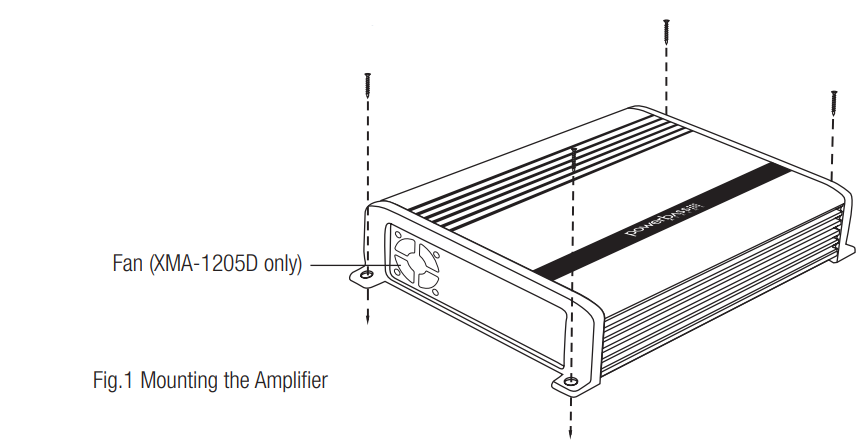
Due to the high power output of the PowerBass Xtreme Class D amplifiers, considerable heat may be produced when the unit is in operation. For this reason the amplifier should be mounted in a location which will allow air to circulate freely. A clearance of at least 2-inches (5 cm) to all sides of the amplifier is necessary not only for proper cooling, but also for gaining access to the inputs and other variable controls. Be sure that the power and signal cable connections can enter and leave the amplifier in
a straight line to avoid the risk of kinked wires causing malfunction.
MOUNTING LOCATION
Find a clear and well ventilated area to mount your amplifier that is unobstructed by any objects that will cause harm or block ventilation. Despite the fact that this amplifier is compact, it still needs air to cool the heatsink fins. Do not mount under a carpet or an area with dead or stagnant air. Without proper air flow the amplifier may overheat and go into protection where the thermal overload circuitry will shut down the amplifier.
NOTE: Make sure not to block the cooling fan (XMA-1205D only)
The amplifier should be protected from exposure to moisture and direct sunlight. The compact size of the amplifier allows greater flexibility in mounting. The best places to mount your amplifier are: The floor of the trunk, under the driver’s seat, or on the back of the rear seat. For alternate installation locations, please consult your authorized PowerBass Dealer.
If mounting under a seat, make sure there is at least 1-inch (2.5cm) of space above the amplifiers heatsink to permit proper cooling. You may use the amplifier as a template and mark the four screw locations with a felt tip pen. Set the amplifier aside before drilling. Use caution to make sure there are no objects behind the installation surface that may become damaged during drilling.
NOTE: Do not use a drill with driver bit to mount the amplifier. Excessive force could cause the plastic mounting feet to crack.
WARNING
- Upside-down mounting will compromise heat dissipation through the heatsink and could engage the thermal protection circuit.
- Try to avoid mounting the amplifier on a subwoofer enclosure, as extended exposure to vibration may cause malfunction of the amplifier.
- Don’t mount the amplifier so that the wire connections are unprotected or are sub-ject to pinching or damage from nearby objects.
- The DC power wire must be fused at the battery positive (+) terminal connection. Before making or breaking power connections at the amplifier power terminals, disconnect the DC power wire at the battery end.
- The battery of the car audio system must be disconnected until the entire wiring and installation is completed.
CONTROL PANEL LAYOUT
XMA-800D

- Line INPUT (RCA) Jacks
These RCA style input jacks are for use with source units that have RCA line level outputs. A source unit with a minimum output of 250mV is required for proper operation. However, this input will accept levels up to 10Vrms. - GAIN Control
This control is used to match the input sensitivity of the amplifier to the particular source unit that you are using up to 10 volts. - AUTO-TURN ON
Eliminates the need to run a dedicated remote wire for amplifier power on/off. Works with high level only (HL-AD2 adapter required as shown on page 13) - PHASE Switch
This switchable control can be used to correct any “phase” or “time delay” effect in the system by bringing the low frequency from the rear of the vehicle to the front. - BRIDGED CONNECTION Port
For externally bridging two of the same model PowerBass Xtreme Class D amps together. Connect the INPUT of the MASTER to a suitable source via a standard telephone wire with RJ11 (4-pin) modular connectors to the jack on the SLAVE amplifier. Then select the MASTER/SLAVE switch properly (see Speaker Output Configuration diagram). - SUB SONIC Control 40 Click Detent Control
This control is continuously adjustable from 10Hz-50Hz at 12dB per octave to provide an extra level of speaker protection from bass robbing power at unheard frequencies. - BASS FREQ Control
This control is variable from 40Hz to 100Hz and allows you to choose the exact frequency you want to boost using the BASS EQ feature. - SLAVE / MASTER Switch
Two like amplifiers can be connected together and externally bridged into a single 2-ohm (min) load. The preamp controls on the SLAVE amp will be disabled. Only the amplifier you select as the MASTER will control these functions. The Dual Link Power Doubling Circuit increases the output power as follows.
NOTE: If using only one amplifier this switch should remain in the MASTER position.- XMA-800D x 2 = 1,600 watts RMS (2 ohms min)
- XMA-1205D x 2 = 2,400 watts RMS (2 ohms min)
- XMA-2000D x 2 = 4,000 watts RMS (2 ohms min)
- XMA-3000D x 2 = 6,000 watts RMS (2 ohms min)
- BASS EQ Control
This equalization circuit is used to enhance the low frequency response of the vehicle’s interior. With up to 18dB of boost varied by the BASS FREQ control, the BASS EQ can be adjusted to meet your own personal taste. - LPF (Low Pass Filter) Control 40 Click Detent Control
This filter allows low pass of frequency and is adjustable from 25Hz through 250Hz to eliminate unwanted high frequencies. - REMOTE LEVEL (RJ12 Jack)
This is the 6-pin connector port for the Remote Level Control. Now the amplifiers secondary gain circuit can be adjusted from the driver’s seat. - POWER/STATUS Indicator Light
This clear LED lights BLUE for power and normal operation, or lights RED when there is a problem. This LED will light RED when the built-on protection circuitry is activated. This indicates there is a problem with the system in relation to the ampli-fier (see Troubleshooting Tips pg 30). - SPEAKER Output Terminals
As shown in the wiring diagrams, be sure to observe speaker polarity through the system and speaker impedance. - COOLING FAN
Variable speed fan pulls cool air in - do not block so air can enter (XMA-1205D only) - FUSES
For convenience most PowerBass Xtreme mini amplifiers utilize common automotive ATC type fuses. For continued protection in the event that a fuse blows, replace the fuse only with the same value.
CAUTION: These power fuses on the amplifier chassis are for protecting the amp against overdrive. To protect the vehicles electrical system, an additional fuse should be used within 18-inches of the battery on the 12V+ cable.- XMA-800D 30A x 3
- XMA-1200D 40A x 3
- XMA-2000D 150A (Requires external fuse - not supplied)
- XMA-3000D 250A (Requires external fuse - not supplied)
NOTE: Due to space limitations, the XMA-2000D and XMA-3000D do NOT use chassis mounted protective fuses. Therefore you must add a fuse and fuse holder (not included) rated at 150A for each XMA-2000D or 250A for each XMA-3000D installed.
- BATT+ (Power Input Connection)
This solderless terminal is the main power input for the amplifier and must be connected directly to the positive (+) terminal of the car battery. This solderless terminal accepts up to 4 gauge wire on XMA-800D and XMA-1205, 0 Gauge on XMA-2000/3000 models. (see Power Cable Selection Chart for recommended wire gauge for each model). - REM (Remote Input Connection)
All PowerBass Xtreme amplifiers can be turned on by applying 12 volts to this terminal. This can be found on the rear of the source unit in the form of a remote output. If this is not available you can wire to the ACC position on the key. An 18 gauge wire is sufficient to run the REMOTE. - GND (Ground Input Connection)
A good quality ground is required for your PowerBass Xtreme Class D amplifier to operate at peak performance. A short length of cable the same gauge as your power cable should be used to attach the ground terminal directly to the chassis of the vehicle. Make sure that all of the paint is sanded or scraped away to ensure a quality ground connection.
Description
The Powerbass XMA-800D is engineered with the latest Class D technology, ensuring high power output with low current draw and minimal heat generation. This makes it an excellent choice for vehicles where space is limited but powerful bass is desired. The amplifier features a sturdy aluminum heatsink that helps dissipate heat efficiently, ensuring reliable operation even during extended use. The adjustable input sensitivity allows for easy integration with various head units and source devices, making it versatile for different car audio setups.
The amplifier's compact size and lightweight design make installation straightforward and hassle-free. Additionally, the XMA-800D includes comprehensive protection circuitry to safeguard against overheat, overload, and short circuits, providing peace of mind for users.
POWER WIRING AND SIGNAL CONNECTIONS
WARNING
Disconnect the negative (-) battery terminal before you start any wiring work! The battery of your car audio system must be disconnected until the entire wiring installation is completed.
Your PowerBass Xtreme Class D amp will draw large levels of current, so use the largest gauge power/ground cable as possible. Using too small of power cable can result in unnecessary over-heating of the amplifier, distortion at high volume levels and might even cause the thermal protection circuitry to shut-off the amplifier. Remember, bigger wire is better!
- Use rubber grommets when running cables through any metal or sharp plastic, to prevent accidental shorting or shearing. Make sure the cables do not interfere with normal operation of the vehicle.
- The audio signal cables (RCA interconnects) should be kept far away from any potential sources of electrical interference such as electronic vehicle management systems (relays, engine computers wiring harnesses, fuel pumps etc.)

This amplifier is designed to work within a 9-16 volt DC range. Before any wires are connected, the vehicles electrical system should be checked for correct voltage supply with the help of a voltmeter.
First, check the voltage at the battery with the ignition in the OFF position. The voltmeter should read no less than 12V. If your vehicles electrical system is not up to these specifications, we recommend having it checked by an auto electrician before any further installation. Once the vehicle is checked, make certain the correct cable gauge is used. We recommend using as large a gauge cable as possible, use the Power Cable Selection Chart to calculate the correct power wire size for your application.
POWER WIRING
BATT+ (Power)
This amplifier should be wired directly to the vehicle battery using the appropriate size cable. Start at the vehicle battery and run the power cable through to the amplifier. Avoid running the power cable over engine components and near heater cores. The use of an inline fuse or circuit breaker is a must; this will pre-vent the risk of a potential fire caused by a short in your power cable.
Connect the fuse holder or circuit breaker as close to the battery positive (+) terminal as possible (no farther then 18” from that battery). This fuse or circuit breaker should be no greater then the sum of the fuses found on the chassis of your amplifier (also see specifications chart). You may now connect the cable to the bat-tery, but remember to leave the fuse out or circuit breaker “off” until all other cable connections are made.
NOTE: Secondary battery power is required for XMA-2000D and XMA-3000D
GND (Ground)
When grounding your amplifier, locate a metal area close to the amplifier that is good source of ground (preferable the floor pan). Once again, investigate the area you wish to use for electrical wires, vacuum lines, and brake or fuel lines. Use either a wire brush or sandpaper to eliminate unwanted paint for better contact of the ground.
Secure the ground cable to the body using a bolt, star washer and nut. Spread silicon over the screw and bare metal to prevent rust and possible water leaks.
_powerbass_class_d_mono_amplifier_xma-800d.png)
Now it’s time to connect the power and ground cables to the amplifier. Cut both cables to length. Strip off 1/2 inch (12mm) of the insulation so that the bare wire fits all the way in the terminal block on the side panel of the amplifier, seating it firmly so no bare wire is exposed. Use an Allen wrench to loosen the BATT+ and the GND connections on the amplifier. Insert the ground first, and then the +12V and please make sure that you place them into the correctly marked terminals. Then tighten the screws down securely by hand.
NOTE: Bare wires should be tinned with solder for maximum current flow.
REM (Remote Trigger)
This terminal must be connected to a switched +12V source. Typically, a remote turn-on lead is provided at the source unit that will turn on and off the amplifier in correspondence with the source. If this lead is not at the source unit, then a switched +12V supply must be used, like the ACC, +12V.
Run a minimum of 18 gauge wire from the amplifier location to the source of the switched +12V lead. If possible, route this wire on the same side of the vehicle as your power cable. Connect the source remote output to the wire. Go back to the amplifier and cut the wire to length. Loosen the screw terminal marked REM on the amplifier. Insert the stripped (bare) portion of the wire into the terminal and tighten the screw securely.
FUSE REQUIREMENTS
While the panel on your PowerBass amplifier may use one or more fuses, these do nothing to protect the vehicle from a dangerous short circuit. It is absolutely vital that the main power lead to the amplifier(s) in the system be fused within 18-inches (45cm) of the connection to the vehicle battery. The value of this fuse (or circuit breaker) should be no greater than the sum of the fuses found on all of the equipment being con-nected to that power wire.
NOTE: Due to space limitations, the XMA-2000D and XMA-3000D do NOT use chassis mounted protective fuses. Therefore you must add a fuse and fuse holder (not included) rated at 150A for each XMA-2000D and 250A for each XMA-3000D installed.
AUTO TURN-ON Button
This unit features a High Level Auto Turn-on circuit that eliminates the need to run a separate Remote Turn-on Lead to the terminal marked REM located between the amplifiers BATT+ and GND power terminals. To engage this circuitry make sure the AUTO TURN-ON button is in the ON (out) position. Requires optional HL-AD2 wiring Harness (see page 13). When this button is the OFF (in) position the amplifier will require a dedicated remote wire to power the amplifier. If you are using the RCA Low Level inputs you will need to run the Remote Turn-on wire and set the button to the OFF (in) position.
CONNECTIONS TO AMPLIFIER FOR BATT+, GND, REM AND SPEAKERS
Your PowerBass Xtreme amplifier features specially tooled solderless terminals for Power (BATT+), Ground, Remote, and Speaker connections. For maximum transfer of Voltage and Signal the bare wire needs to be inserted as far as possible into the terminal before tightening the set screw. For Power (BATT+) and Ground connections it is highly recommended that the bare ends of the wires are tinned with solder before inserting them into the terminal. Hand tighten the set screw and make sure the connection is secure to prevent possible arcing due to loose screws.

RCA INTERCONNECT WIRING
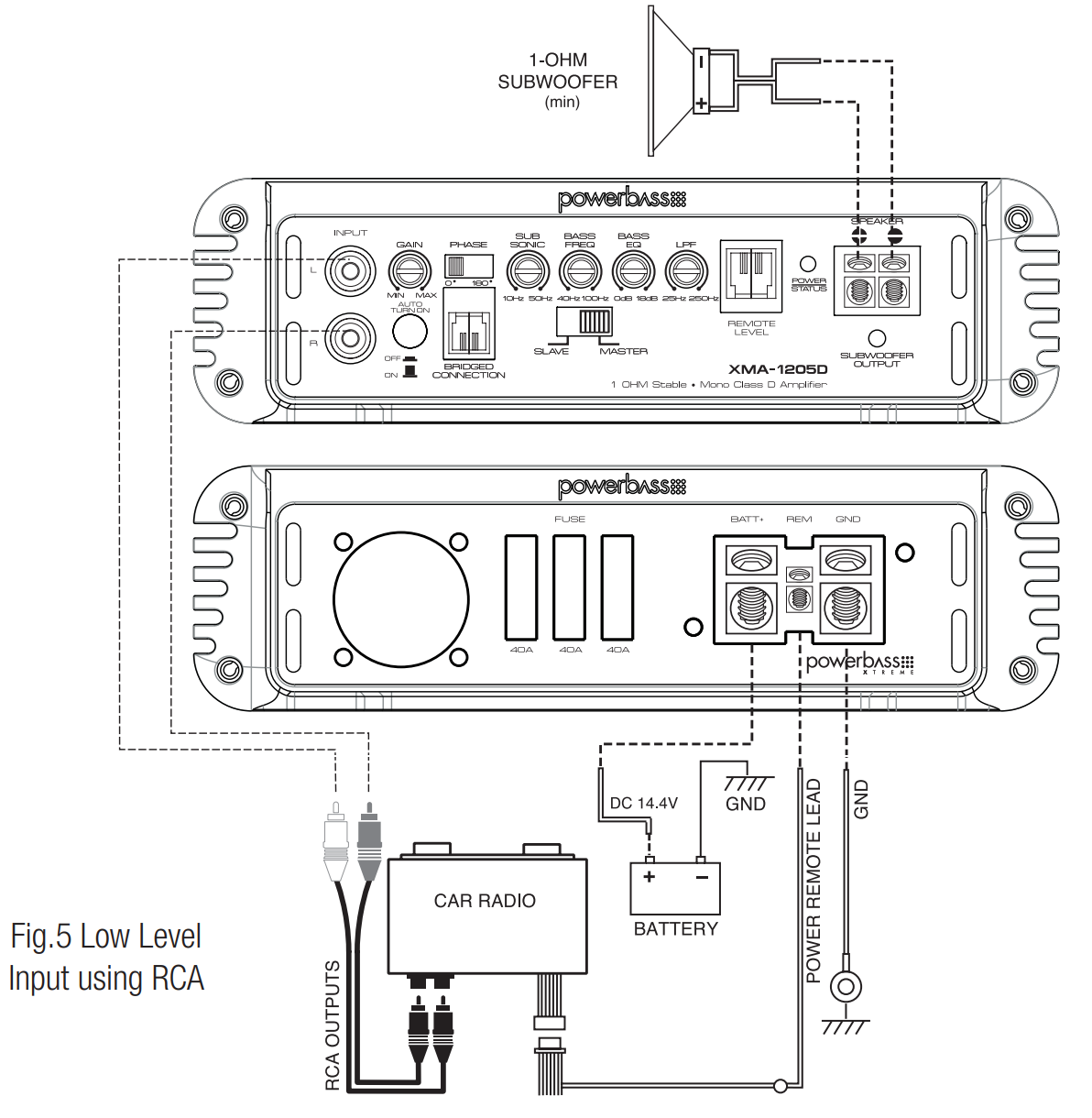
Low-Level Input
- Choose the correct length and style of RCA interconnects for your needs. Always use high quality RCA audio cables (not supplied) for signal connections—those with multiple layers of shielding or a twisted pair variety for better noise rejection.
Be extra careful when routing your RCA audio interconnect cables. - Car environments are notorious for poorly insulated wires. This means that hiss, engine noise, and fan noise can easily be picked up through RCA cables if run incorrectly.
Make sure that the cables for power and audio signal are not on the same side of the vehicle and that they do no cross each other; this will help reduce any noise that may radiate from the power cable and the signal cable. - If an audio cable is too close to a power cable, it may pick up the magnetic field generated by the power cable, which could lead to a loss of quality in your signal.
HIGH INPUT PLUG
The balanced input of this XMA series amplifier can receive either low RCA or high speaker lead level signals from the source unit (radio). A high level signal can be run from the source units speaker lead outputs to the low level RCA amplifier inputs via the PowerBass HL-AD2 wiring harness (available separately as shown below).

SET UP ADJUSTMENTS
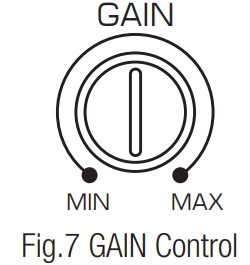
Input GAIN Adjustment
This control allows you to match the input level of the amplifier to the output level of your head unit. Matching the input can be accomplished in four simple steps:
- Make sure that the remote level control is not plugged in until after the master gain control is set.
- Set the GAIN control on the amplifier to Min (completely counter clock wise).
- Turn on the head unit and adjust volume to 2/3 maximum, and set the BASS and TREBLE to zero.
- Adjust the GAIN control clockwise until the sound just begins to distort, then back off slightly to cut distor-tion and operate at optimum gain.
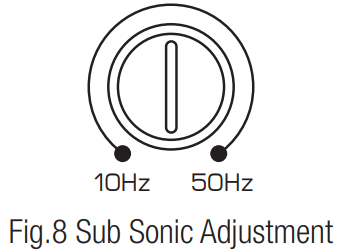
SUB SONIC 40 Click Detent Control
The subsonic control will filter out all frequencies below where the control is set and prevent those frequencies from going to your subwoofer(s). This will prevent your subs from playing any low frequencies that may harm the speaker. When this amplifier is used with a subwoofer in a Vented Woofer application it is important to set the frequency of the filter to cutoff ½ octave below the vent frequency.
This will prevent the woofer unloading from bass notes which are too low for the vented woofer. Once the woofer is unloaded it is operating as a free air driver and may experience damage by striking the back plate or by shearing off the spider. Proper setting of the subsonic filter is critical.
See the chart on page 28 to set the subsonic filter to the precise cutoff frequency.

LPF (Low Pass Filter) Adjustment
The crossover frequency adjustment filters out frequencies that you don’t want your subwoofer(s) to repro-duce. Using the LPF control, adjust the Low Pass Frequency to limit the amount of mid range you want going to your woofer(s). Since musical tastes vary, adjust the crossover by ear while listening to the music of your choice. Be sure to set the tone controls of your source unit to flat before adjusting the crossover.
See the chart on page 28 to set the Low Pass filter to the precise frequency.
_adjustment_powerbass_class_d_mono_amplifier_xma-800d.png)
Adjusting the BASS EQ and BASS FREQ Controls
- The BASS EQ is adjustable from 0-18dB, thus allowing you to tailor your sound system to your particular tastes.
- The BASS FREQ control has 40 click detents that allow you to choose precisely the frequency the BASS EQ will boost. Refer to the chart on page 28 and find the setting of the BASS FREQ and determine what frequency you want the BASS EQ to boost.
- You will want to experiment with both controls—begin your adjustments at low volume.
- Next turn the BASS EQ control about half-way up. Adjust the controls until you find the right combina-tion that sounds best with the music you listen to most.
NOTE: More is not always better. By turning the BASS EQ all the way up to 18dB you can overwork the amplifier and send the unit into thermal protection.

REMOTE LEVEL Controller Connection
Your PowerBass Xtreme Class D amp includes a Remote Level control module. It uses standard telephone wire and telephone RJ12 connectors. To connect the Remote Level Control to the amplifier, simply insert one end of the 6-pin telephone plug into the REMOTE LEVEL port. Plug the other end into the remote module. Install the module within easy reach on or under your dash.
SPEAKER WIRING AND CONFIGURATIONS
Speaker Load
The minimum speaker impedance is 1 ohm. Unless you are externally bridging two XMA amplifiers in which case the minimum load is 2-ohms. If you are unsure of calculating impedance loads please consult your Authorized PowerBass Dealer before damaging your amplifier.
Lower impedance will send the amplifier into protection and possibly damage the electronics inside.
Note: Know your load before connecting speakers.
SPEAKER OUTPUT CONFIGURATIONS
Speaker Wiring
Choose the correct speaker wire for your application. We recommend a minimum of 14 gauge wire. Route these using the same precautions as you did when you ran the power cable. Terminate these wires at the speaker end using insulated speaker terminals (not supplied) or by soldering the connection to the speaker. Be certain to maintain correct polarity throughout the system. Make sure the speaker connections are positive-to-positive and negative-to-negative. Most speaker wire has some indicator (color code, ribbing, or printing) on one of the two wires to help you distinguish the positive (+) and negative (-) leads.
At the amplifier end, insert the stripped (bare) speaker wires into the properly marked terminals. Use an Allen wrench to loosen the speaker terminals on the amplifier. Make certain that no bare wire ends touch each other. Such contact could result in an electrical short and cause the amplifier to turn off (short circuit protection) or malfunction.
NOTE: It is highly recommended that an Allen wrench is used to tighten the set screws in the terminal blocks by hand and NOT a power drill. This will prevent stripping or other possible damage to the amplifier.
XMA-800D SPEAKER OUTPUT CONFIGURATIONS
1-OHM STABLE DESIGN Minimum Impedance Load is 1-Ohm
1. A SINGLE VOICE COIL SUBWOOFER SPEAKER
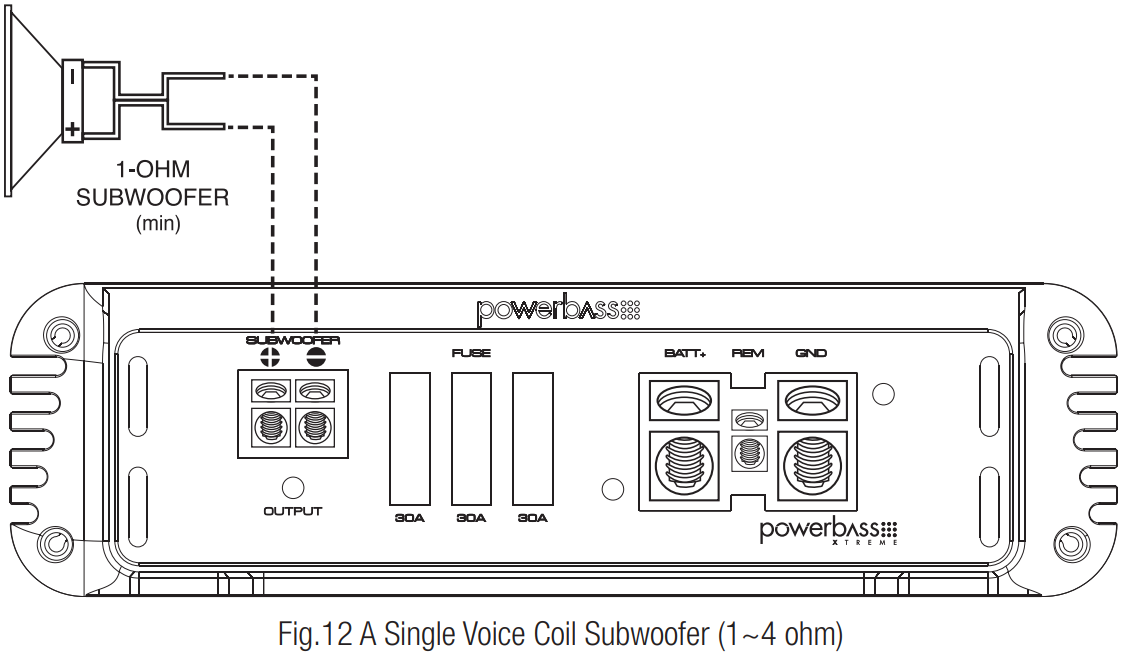
2. TWO SINGLE VOICE COIL SUBWOOFER SPEAKERS
(Note: Don’t connect speaker impedance under 1 ohm)
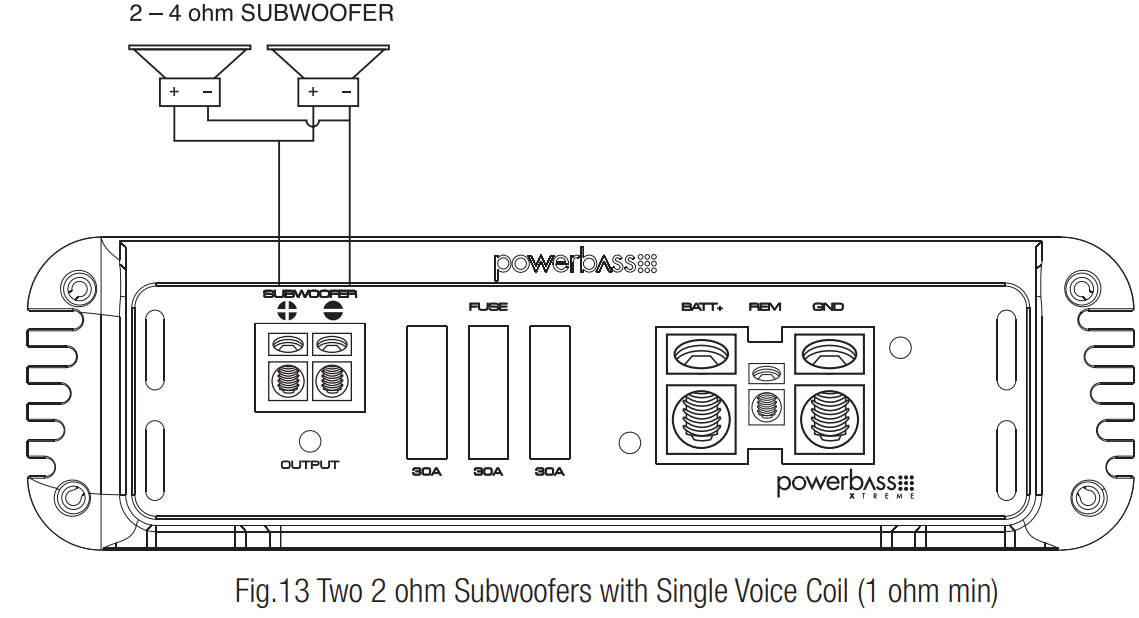
DUAL LINK AMP TO EXTERNAL BRIDGING XMA-800D
The PowerBass XMA Class D Mono amplifiers are equipped with a special Dual Link circuitry that allows you to link (strap) two like amplifiers together and double the output power at a minimum 2-ohm load.
External Bridging two amplifiers (must be the same models) can be done via the MASTER and SLAVE switches, BRIDGGED CONNECTION cable and proper speaker wiring. Doing so will allow only the preamp controls (Gain, X-Over, Subsonic, Bass EQ, etc) on the MASTER amplifier to control both amplifiers. The preamp controls on the SLAVE amplifier will become inactive. This holds true for the Remote Level Control as well, it will only function with the MASTER amplifier.
Follow the preceding diagrams carefully when using the Dual Link function. Make sure the MASTER and SLAVE switches are properly selected on each amplifier as shown in Fig 16. Failure to do so will result in damage to the system.
NOTE: This switch should always be set to the MASTER position for standard operation of one amplifier. Changing the position to SLAVE will result in no output

Plug the RJ-11 (4-pin) telephone-style cable into the BRIDGED CONNECTION port on both amplifiers.
When configured for Dual Link (external bridging) the minimum impedance load increases from 1-ohm to 2-ohms. DO NOT install or use these amplifiers by wiring woofers rated at 2-ohm or lower in parallel to achieve a 1-ohm (or lower) total impedance.

The mono woofer must be connected between the speaker positive (+) terminals of the two amplifiers and use at least 12-gauge speaker wiring. Install a 12-gauge wire link between the speaker negative (-) termi-nals of the two bridged amplifiers. Permanent amplifier damage, smoke and overheating could result from improperly bridging the amplifiers.
DUAL LINK CAUTION! When externally bridging the speaker outputs as shown above, the amplifier must see a 2-ohm load or higher. If an impendance load of less than 2-ohms is used, you will eventu-ally damage the internal electronic components and void your warranty!
40 CLICK PRECISION ROTARY CONTROLS

These controls allow precise set-ting of the electronic crossover and subsonic settings on the amplifier, thus taking the guesswork out of tuning your speakers. Using a small slotted screwdriver make sure the controls are turned all the way to the left (counter clockwise). Refer to the chart and count the clicks (advancing one detent at a time clockwise) until you have reached the desired frequency.
This precise method of setting the crossover controls is available for the LPF, SUBSONIC and BASS FREQ features on this amplifier.
XMA-800D
Click Position | Low Pass Freq | Subsonic Freq | Bass Freq |
1 | 33Hz | 10Hz | 46Hz |
2 | 33Hz | 10Hz | 46Hz |
3 | 33Hz | 10Hz | 46Hz |
4 | 33Hz | 10Hz | 46Hz |
5 | 33Hz | 10Hz | 46Hz |
6 | 33Hz | 10Hz | 46Hz |
7 | 33Hz | 10Hz | 47Hz |
8 | 34Hz | 10Hz | 47Hz |
9 | 34Hz | 11Hz | 47Hz |
10 | 34Hz | 12Hz | 48Hz |
11 | 35Hz | 12Hz | 48Hz |
12 | 37Hz | 13Hz | 49Hz |
13 | 39Hz | 13Hz | 50Hz |
14 | 41Hz | 14Hz | 52Hz |
15 | 43Hz | 14Hz | 53Hz |
16 | 45Hz | 15Hz | 54Hz |
17 | 47Hz | 15Hz | 56Hz |
18 | 49Hz | 16Hz | 58Hz |
19 | 52Hz | 16Hz | 59Hz |
20 | 56Hz | 17Hz | 61Hz |
21 | 59Hz | 17Hz | 62Hz |
22 | 62Hz | 18Hz | 64Hz |
23 | 69Hz | 19Hz | 67Hz |
24 | 72Hz | 21Hz | 69Hz |
25 | 78Hz | 23Hz | 71Hz |
26 | 84Hz | 24Hz | 74Hz |
27 | 92Hz | 26Hz | 77Hz |
28 | 102Hz | 29Hz | 80Hz |
29 | 125Hz | 32Hz | 82Hz |
30 | 145Hz | 36Hz | 86Hz |
31 | 170Hz | 42Hz | 90Hz |
32 | 187Hz | 43Hz | 94Hz |
33 | 200Hz | 47Hz | 96Hz |
34 | 225Hz | 49Hz | 98Hz |
35 | 240Hz | 50Hz | 100Hz |
36 | 248Hz | 51Hz | 100Hz |
37 | 255Hz | 52Hz | 101Hz |
38 | 258Hz | 53Hz | 101Hz |
39 | 262Hz | 54Hz | 102Hz |
40 | 265Hz | 54Hz | 102Hz |
RECOMMENDED WIRE SIZES
Power Cable Selection Chart | |||||||
Fuse Total | 4Ft | 4-7Ft | 7-10Ft | 10-13Ft | 13-16 Ft | 16-19 Ft | 19-22 Ft |
In Amperes | Length of Wire/Gauge | ||||||
250A+ | *1/0* | *1/0* | *1/0* | *1/0* | *1/0* | *1/0* | *1/0* |
150A - 200A | 2 GA | 2 GA | 2 GA | *1/0* | *1/0* | *1/0* | *1/0* |
125A - 150A | 4 GA | 4 GA | 4 GA | 4 GA | 2 GA | 2 GA | 2 GA |
105A - 125A | 8 GA | 8 GA | 8 GA | 4 GA | 4 GA | 4 GA | 2 GA |
85A - 105A | 8 GA | 8 GA | 8 GA | 4 GA | 4 GA | 4 GA | 4 GA |
65A - 85A | 10 GA | 8 GA | 8 GA | 8 GA | 4 GA | 4 GA | 4 GA |
50A - 65A | 10 GA | 10 GA | 8 GA | 8 GA | 8 GA | 8 GA | 8 GA |
PowerBass makes several types of amplifier wiring kits to assist with your installation. Consult your local PowerBass dealer for details. For more information about recommended power wire check out our website at https://www.powerbassusa.com
TROUBLESHOOTING
Problem | Solution |
Power LED not ON | With a Volt Ohm Meter (VOM) check: • +12 Volt powerterminal (should read+12 to +16VDC
|
Power LED lights BLUE, no output |
|
Red Status Protection LED is ON,no output and
|
|
Alternator noise (varies with RPM) |
|
Poor Bass Response |
|
NOTE: If the Status L.E.D. is activated and glows RED with no speakers connected to the amplifier, and all the power connections are correct, this would indicate an internal problem with the amplifier. Contact PowerBass USA or your local dealer.
WARRANTY POLICY
PowerBass Xtreme Amplifiers are to be free of defects in material and workmanship for a period of one (1) year.
This warranty covers only the original purchaser of PowerBass product. In order to receive service, the purchaser must provide PowerBass with the receipt stating the consumer name, dealer, product and date of purchase.
Powerbass XMA-800D Pros & Cons
Pros
- High Efficiency: Class D technology reduces heat generation and conserves energy.
- Compact Design: Easy installation in tight spaces without compromising on performance.
- Flexible Input Sensitivity: Adjustable sensitivity for easy integration with various head units.
- Durable Construction: Sturdy aluminum heatsink ensures long-lasting performance.
- Comprehensive Protection Circuitry: Safeguards against common issues like overheating and short circuits.
Cons
- Limited Frequency Response: Designed specifically for subwoofer applications; not suitable for full-range speakers.
- No Built-in Crossover Controls: Requires external crossover settings if needed.
Customer Reviews
Customers praise the Powerbass XMA-800D for its robust performance and reliable operation. Many users appreciate its compact size and ease of installation. However, some reviewers note that it lacks built-in crossover controls which may require additional equipment setup. Overall, it is well-regarded among car audio enthusiasts seeking powerful bass output without breaking the bank.
Faqs
What is the maximum power output of the Powerbass?
How do I adjust the input sensitivity on my XMA-800D?
What type of cooling system does this amplifier have?
How do I protect my PowerBass from overheating?
What kind of wiring connections does this amplifier support?
How do I troubleshoot if my amplifier is not producing sound?
Can I run multiple subwoofers with this PowerBass Class D Mono Amplifier XMA-800D?
Is there any protection circuitry built into this amplifier?
Leave a Comment
